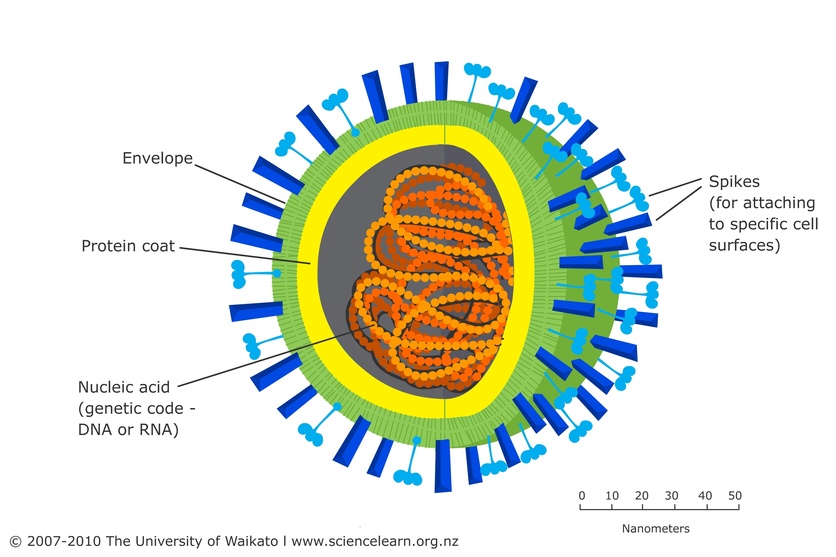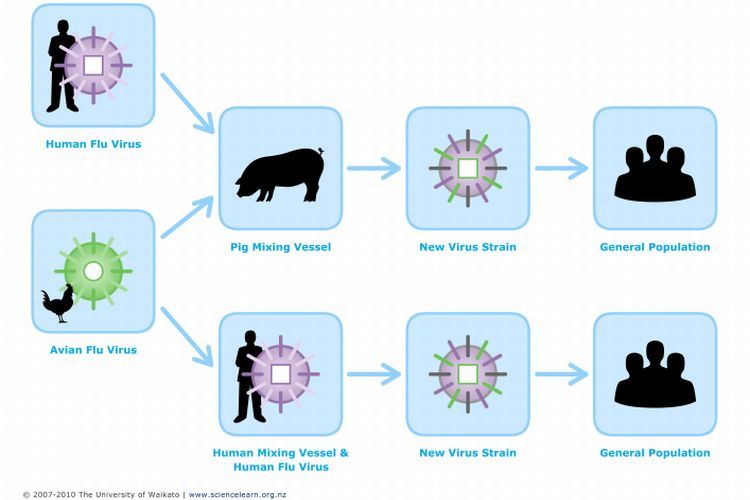A virus is a very simple thing – a coat of protein wrapped around some genetic code (DNA or RNA). It’s not a cell and it’s not living.
Hijacking a host cell
A virus needs a host cell to be able to replicate itself. Once inside the host cell, it takes over. The cell is reprogrammed to produce the virus instead of doing what it was designed to do before. The virus is replicated thousands and thousands of times within that cell. Eventually, the cell bursts open and the multitude of viruses move around the body infecting other cells. This can happen within a few hours.
Mutation
Mutation is when something changes as it is replicating. Viruses survive through mutation. This is a random act, rather than a deliberate act of survival.
Some of the ways that viruses replicate are quite sloppy compared to the cells in our bodies. Our cells have special enzymes that make sure that a new cell has copied the gene sequence perfectly, but a virus is not so exact. The host cell (under instruction from the genetic material of the virus) produces, say, 50,000 copies of the virus, but they are often not going to be 100% exact.
Dr Joanna Kirman from the Malaghan Institute of Medical Research in Wellington likens it to someone writing the alphabet. You might be writing the alphabet but instead of writing a J you make an extra N. It might be a small mistake, but even small mutations within a virus can create a new strain which our immune system might not recognise. This results in the mutated virus infecting a new cell making thousands – millions of copies of the new mutation without our immune system being able to stop it, as it has not had time to produce matching antibodies. Mutations can also have other impacts, a virus may become more infectious or it may become less infectious and some mutations result in a virus not surviving.
You can have lots of strains (slight variations) of the same virus. Some viruses are sloppier than others when replicating and have many mutations. HIV (human immunodeficiency virus) is an example of this.
Reassortant strains
Influenza (flu) and rotavirus also produce many different strains. They do this in a slightly different way from mutation. These viruses can make reassortant strains, meaning the strain is produced from the genetic material from two or more similar viruses.
This happens when the gene material is chopped up in little pieces (rather than being in one long piece as with other viruses). Say you caught two different strains of the flu at once from two different people. A cell in your body could get infected with these two different strains. The strains can jumble up within the host cell and mix and match their little pieces of genetic material to create a new, dramatically different strain. This is how a flu pandemic occurs. The reassortant can spread quickly. Nobody’s immune system recognises the new virus strain so it is able to spread rapidly.
Scientists believe that this is how the swine flu (H1N1 virus) came about in 2009. A study of the gene sequence of the most recent swine flu shows it’s a mix and match of swine flu, bird (avian) flu and human flu. It’s got genes from three different types of flu that have jumbled up together. Because this virus made so many people around the world get sick, the World Health Organization declared H1N1 flu to be a pandemic. Fortunately, the pandemic was short-lived and the virus is now one of the strains that cause seasonal flu.
Nature of science
Scientists study immune response to viruses so they can develop vaccines and therapies to stop them. However, scientific knowledge is based on our knowledge at the time observations are made. Because viruses mutate and re-assort rapidly, it is difficult for scientists to keep up with scientific knowledge of new viruses. As a result, pandemics can occur.
Related content
This article is about coronaviruses, a group of viruses that cause upper respiratory illnesses in humans. In 2020, the COVID-19 virus started a global pandemic.
Use the activity Viruses and immunity – interpreting infographics to grow literacy skills and build conceptual understanding and then put the information to use to design a game about viruses, vaccines and immunity.
Collection
We have curated content in the Viruses and the immune system collection – it explores viruses and how our immune system fights them. Log in to make this collection part of your private collection. Click on the copy icon, and then you can add additional content and notes and share and collaborate with others.
Useful links
Read Ten Years of Gains: A Look Back at Progress Since the 2009 H1N1 Pandemic from the Centers for Disease Control and Prevention.
Unite against COVID-19 has up-to-date information about the COVID-19 pandemic in Aotearoa New Zealand.


